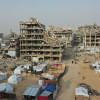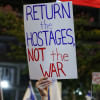How the unjustifiable war in Gaza is justified

"Ramadan is the best time to kill them. They're weak and tired," said Almog Cohen, a member of the Israeli Knesset, urging Prime Minister Benjamin Netanyahu to attack Rafah and massacre the Palestinian people. This critical statement, which shows the extent of dehumanisation, has been conspicuously absent from Western media coverage. Due to the extensive control exerted by the Zionist lobbies within the Western media, they lean towards omitting information regarding the Israelis' inhumane school of thought, and engage in corroding the image of Palestinians. This critical statement is among the numerous pieces of information withheld by Western media outlets from their wider audience. Yet, it is essential to recognise that the concealment of such news contributes to the propagation of propaganda, influencing public opinion in a misleading manner.
Disinformation, dehumanisation of victims, and protecting the perpetrators are all important processes that are used in the construction of narratives in mainstream media publications. Especially during times of war, propaganda in the media is a prevalent practice. By using the Western media as their megaphone and pawn to repeat their words, carry out their directions, and most importantly, engage in defamation, intimidation, and the embellishment of falsehoods, Western politicians have legitimised bias, as the truth.
The persistent association of Hamas with ISIS is a part of a deliberate attempt by the Western media to depict all Palestinians as "terrorists." This narrative makes it easier for people to sympathise with Israel, and desensitises them towards Palestinians.
The first type of propaganda in the genocide in Palestine is disinformation. Images of affected newborns in Gaza were released by The Times of London with the title, "Israel releases pictures of mutilated babies," to allege proof of the October 7, Hamas attacks. The Western media, far from fact-checking, parroted the Israeli propaganda, claiming the possession and verification of harrowing images of "babies" murdered by Hamas. The Times mentioned in their article, that they refuse to publish images of Israeli infants with mutilations because they were "too graphic." Later on, an investigation by Haaretz, found that no babies were beheaded during the October 7, Hamas attacks.
The media engaged in "pre-attack legitimacy," purposely broadcasting content with the intention of either convincing their audience that a certain act of assault ought to take place or assisting viewers in comprehending that an attack is on the horizon. Everything started as soon as the events of October 7th occurred, when an official US statement quickly described the Hamas attacks as an "unprovoked terrorist attack." The "unprovoked" component reverberated through the media, and was repeatedly used by politicians. Both of these combined serve to convince the audience that Hamas carried out a heinous terrorist attack, with no underlying reason other than sheer ruthlessness and inhumanity.
This "pre-attack" rhetoric prepares the audience to view the Israeli attacks in response as acts of "self-defense." In reality, the international community has been ignoring the citizens of Gaza for many years—the fact that they live in an open-air prison—and the decades-long misery that the Palestinians have been living through. Establishing pre-attack legitimacy, the second component of propaganda is essentially the process of justifying the overt and unjustifiable Israeli aggression, in a twisted way of making the attacks "acceptable" to the general public. Take for example, BBC which released information alleging that hospitals were being utilised as Hamas tunnels, the day before a hospital in Gaza was bombed.
The third phase of propaganda served to dehumanise the victims. The Western media has, for the most part, focused on the victimhood of Israelis, while entirely ignoring the Palestinian side. The bias was crystal clear, as commonly liberal magazines pursued large-scale reporting of the victims of the October 7 attacks, in abundance, while ignoring the Palestinians, who were also being killed in a genocidal campaign. Stories spotlighting the families of October 7 hostages by Hamas received unilateral attention compared to all the families whose lives were also shattered by Israel's grueling response.
In the first few months of war, it was evidently clear that this was going to be disastrous for the civilian population in Gaza; the Israeli government had cut off the Gaza Strip, which prevented the delivery of fuel, food, and water as well as the supply of electrical power. Israeli fighter jets began their bombardment of the besieged region; whole neighborhoods were soon reduced to rubble. For months, none of these received the attention of Western media outlets. On the other hand, false information—including accounts of Israeli civilians being burned and decapitated, women being raped—were spread by top politicians in the West, including the president of the US.
It would not be too far-fetched to question whether the objective of the Western media has been to liken Hamas to well-known terrorist groups, such as the Islamic State of Iraq and Syria (ISIS). The persistent association of Hamas with ISIS is a part of a deliberate attempt to depict all Palestinians as "terrorists." This narrative makes it easier for people to sympathise with Israel, and desensitises them towards Palestinians. As a result, the global society as a whole has been more bent to assume that Israel is the victim, which in return normalises the mass murder of Palestinians. Despite the historic pace with which Palestinians have been murdered, the conflict of Israel-Palestine is somehow still up for debate, due to the normalisation of genocide itself.
Protecting the perpetrators, the fourth stage of the propaganda can be witnessed in the Western media's coverage of Israeli and Palestinian lives lost in the conflict. Israelis are described as "killed," while Palestinians are said to have "died." Take for example, a headline in The New York Times: "How Gaza Civilians Have Fared After Israel Has Asked Them to Flee." The article itself, published on March 19, 2024, delved into how nearly 2 million Palestinians are facing "forced starvation" as a direct consequence of the Israeli government's actions. It is, therefore, diluted at best and dishonest at worst, to suggest that people in Gaza are "faring." The phrase, Israel "asked" them to "flee," almost criminally underplays the ground reality. It seems as though the Israeli Army are nicely asking Palestinians to evacuate, when the reality is that they are killing them wherever they themselves are telling them to go. The language itself reeks of preconceived bias and reveals the hidden propaganda that is ensconced in the Western media's coverage of the genocide.
On the other hand, due to the proliferation of social media, many users in Gaza have become "self-proclaimed journalists." In an effort to counter the false narratives and demonstrate the real horrors, Gazans have made this effort by utilising their social media accounts to broadcast real-time images, videos, first-hand accounts of those who have been injured, and stories of families who are dealing with terrible losses. Motaz Azaiza, Plestia Alaqad, Bisan Owda, and Saleh Al Jafarawi are just a few of the names that will live on in this historic moment for public service journalism.
At the end of the day, the Western media will never properly refer to what's happening as a genocide; rather, they still believe it all started on October 7, 2023. But in fact, there have been massacres in Gaza in 2021, 2018-2019, 2014, 2012, 2008-2009, the battle of the Jenin refugee camp in 2002, the massacre at the Ibrahimi mosque in 1994, the slaughter at the Al-Aqsa mosque in 1992, the massacre at Sabra and Shatila in 1982, and a lengthy list of previous assaults going back to 1948.
Despite the Western media's inclination towards aligning with Israel, countries such as Bangladesh who have shown their constant support for Palestine serve as a source of inspiration for Palestinians, bolstering their resilience and fostering optimism over the eventual liberation of Palestine. The Palestinians will forever be commemorated as the individuals who have consistently reminded the global community of their presence and unwavering determination to oppose oppression by colonialism. Palestinians will be remembered as individuals who were previously prohibited from flying their flags, which caused them to substitute watermelons instead, partly due to their remarkable resemblance to the flag. Palestinians will continue to be symbolised as the "Al-Badawi" olive tree—which is situated in Bethlehem, Palestine—which means "The Great One," and is believed to be 5,000 years old. No matter what happens, Palestinians will resist; they will remain in Gaza because Israelis are aiming to wipe out a people whose strength against oppression is as deeply ingrained as the roots of the Al-Badawi olive tree.
Nada Yousef Ramadan is pursuing International Relations at the American University in the Emirates, UAE.
We welcome your contributions and analysis of global events. To submit articles to our weekly page, Geopolitical Insights, please send an email to [email protected]
Follow The Daily Star Opinion on Facebook for the latest opinions, commentaries and analyses by experts and professionals. To contribute your article or letter to The Daily Star Opinion, see our guidelines for submission.

 For all latest news, follow The Daily Star's Google News channel.
For all latest news, follow The Daily Star's Google News channel. 










Comments